Impact Assessment of Changing Landcover on Flood Risk in the Indus River Basin Using the Rainfall–Runoff–Inundation (RRI)
Abstract
:1. Introduction
2. Materials and Methods
2.1. Description of the Study Area
2.2. Rainfall–Runoff–Inundation (RRI) Model
2.3. Gauged Rainfall and Runoff Data
2.4. Validation of the Results
2.5. Sensitivity Experiments
3. Results and Discussion
3.1. Reproductive Experiments
3.2. Sensitivity Experiments Using RRI
4. Conclusions
- 1.
- Comparing the RRI model with the original flooding case of 2015 with NSE coefficients of 0.83 and 0.67 at Tounsa Barrage and Trimmu head works, respectively, and a fit value (%) of 0.67 at the confluence point area, the RRI simulation results of the land cover change experiments showed that the inundation pattern was affected by land cover changes. Extreme urbanization increased the risk of inundation and extreme afforestation greatly affected inundation in the Indus basin.
- 2.
- A two-dimensional inundation map of the planting case (Case 6) showed that the inundation area was significantly affected by planting in the Indus basin. Planting in the bare and vegetation area in the upper Indus basin significantly reduced inundation and the flow of the main Indus River and contributed to flood disaster prevention in the high-risk area of the upper Indus basin. Planting between the Indus and Chenab Rivers showed a major effect on inundation after the confluence point of both rivers. At Trimmu head works in the Chenab River, planting (Case 6) showed that the discharge curve almost matched the complete afforestation in Case 3. Planting between rivers was shown to be extremely effective in reducing inundation after the confluence point.
- 3.
- Sensitivity experiments involving only urbanization cases (Case 2 and Case 5) had a small impact on the upper Indus basin and downstream target area. The case of planting with urbanization (Case 7 and Case 8) showed that planting affected the upper Indus basin. However, compared with the planting in Case 6, these urbanization cases greatly affected the discharge curves and inundation after the confluence point. Both cases of urbanization with planting showed that there was an inundation area after the confluence point. Small-scale urbanization did not significantly impact the peak discharge whereas large-scale urbanization caused increased surface flows, leading to more severe flooding; reducing the discharge through planting was a highly effective technique. Therefore, both urbanization and planting were required; this measure can be considered to be a sustainable development method.
Author Contributions
Funding
Institutional Review Board Statement
Informed Consent Statement
Data Availability Statement
Acknowledgments
Conflicts of Interest
References
- Manzoor, M.; Bibi, S.; Manzoor, M.; Jabeen, R. Historical Analysis of Flood Information and Impacts Assessment and Associated Response in Pakistan (1947–2011). Res. J. Environ. Earth Sci. 2013, 3, 139–146. [Google Scholar] [CrossRef]
- Annual Flood Reports 2020. Available online: https://ffc.gov.pk/annual-flood-reports/ (accessed on 20 April 2022).
- Rahman, G.; Rahman, A.; Anwar, M.; Ahmed, M. Socio-economic Damages caused by the 2014 Flood in Punjab Province, Pakistan. Pak. Acad. Sci. B. Life Environ. Sci. 2017, 54, 365–374. [Google Scholar]
- Malik, S.M.; Awan, H.; Khan, N. Mapping vulnerability to climate change and its repercussions on human health in Pakistan. Glob. Health 2012, 8, 31. [Google Scholar] [CrossRef] [PubMed] [Green Version]
- Shah, S.M.H.; Mustaffa, Z.; Teo, F.Y.; Imam, M.A.H.; Yusof, K.W.; Al-Qadami, E.H.H. A review of the flood hazard and risk management in the South Asian Region, particularly Pakistan. Sci. Afr. 2020, 01, e00651. [Google Scholar] [CrossRef]
- Salma, S.; Rehman, S.; Shah, M.A. Rainfall Trends in Different Climate Zones of Pakistan. Pak. J. Metrol. 2012, 9, 37–47Khan. [Google Scholar]
- Hashmi, M.S. Land distribution, technological changes and productivity in pakistan’s agriculture: Some explanations and policy options. Int. J. Econ. Manag. Sci. 2011, 1, 51–74. [Google Scholar]
- Samie, A.; Deng, X.; Jia, S.; Chen, D. Scenario-based simulation on dynamics of land-use-land-cover change in Punjab province, Pakistan. Sustainability 2017, 9, 1285. [Google Scholar] [CrossRef] [Green Version]
- Aziz, T. Changes in land use and ecosystem services values in Pakistan, 1950–2050. Environ. Dev. 2021, 37, 100576. [Google Scholar] [CrossRef]
- Lutz, A.F.; Immerzeel, W.W.; Kraaijenbrink, P.D.A.; Shrestha, A.B.; Bierkens, M.F.P. Climate change impacts on the upper indus hydrology: Sources, shifts and extremes. PLoS ONE 2016, 11, e0165630. [Google Scholar] [CrossRef] [Green Version]
- Qasim, S.; Nawaz, A.; Peasad, R.; Qasim, M. Risk perception of the people in the flood prone Khyber Pukhthunkhwa province of Pakistan. Int. J. Disaster Risk Reduct. 2015, 14, 373–378. [Google Scholar] [CrossRef]
- Hussain, M.S. A Classification of Rainfall Regions in Pakistan. J. Korean Geogr. Soc. 2009, 44, 605–623. [Google Scholar]
- Provincial Disaster Management Authority (PDMA) Government of The Punjab. Available online: https://pdma.gop.pk/flood_maps (accessed on 20 April 2022).
- Ahmad, D.; Afzal, M. Flood hazards and agricultural production risks management practices in flood-prone areas of Punjab, Pakistan. Env. Sci Pollut Res 2022, 29, 20768–20783. [Google Scholar] [CrossRef] [PubMed]
- 2D Hydrodynamic Model for Flood Vulnerability Assessment of Lower Indus River Basin, Pakistan. Available online: https://ascelibrary.org/doi/abs/10.1061/9780784481400.044 (accessed on 20 April 2022).
- Numerical Study on Flood Routing in Indus River. Available online: https://www.researchgate.net/publication/273775519 (accessed on 20 April 2022).
- Shokory, J.A.N.; Tsutsumi, J.I.G.; Sakai, K. Flood Modeling and Simulation using iRIC: A Case Study of Kabul City. E3S Web Conf. 2016, 7, 04003. [Google Scholar] [CrossRef] [Green Version]
- Sayama, T.; Ozawa, G.; Kawakami, T.; Nabesaka, S.; Fukami, K. Rainfall-runoff-inundation analysis of the 2010 Pakistan flood in the Kabul River basin. Hydrol. Sci. J. 2012, 57, 298–312. [Google Scholar] [CrossRef]
- Scharenberg, W. Hydrological Modeling System HEC-HMS; Publication of US Army Corps of Engineers: Davis, CA, USA, 2016. [Google Scholar]
- Beven, K.J.; Lamb, R.; Quinn, P.F.; Romanowicz, R.; Freer, J. Topmodel Computer Models of Watershed hydrology; Water Resource Publications: Colorado, CO, USA, 1995; pp. 627–668. [Google Scholar]
- Liang, X.; Lettenmaier, D.P.; Wood, E.F.; Burges, J.S. A simple hydrologically based model of land surface water and energy fluxes for general circulation models. J. Geophys. Res. 1994, 99, 14415–14428. [Google Scholar] [CrossRef]
- International Centre for Water Hazard and Risk Management (ICHARM). IFAS ver 2.0 Technical Manual 2014. Available online: https://www.pwri.go.jp/icharm/research/ifas/ifas_2.0_top.html (accessed on 20 April 2022).
- Solver Manual. Available online: https://i-ric.org/en/download/nays2dflood-solver-manual/ (accessed on 20 April 2022).
- Deltares. User Manual. SOBEK. In Hydrodynamics, Rainfall-Runoff and Real-Time Control, 1D/2D Modelling Suite for Integrated Water Solutions; Deltares: Delft, The Netherlands, 2019; pp. 1–3. [Google Scholar]
- Sayama, T.; Rainfall-Runoff-Inundation (RRI) Model Technical Manual. The International Centre for Water Hazard and Risk Management 2014. Available online: https://www.pwri.go.jp/icharm/research/rri/index_j.htmlhttps://www.pwri.go.jp/jpn/results/db/doken_kankoubutu/doken_shiryou/files/doken_shiryou_4277_00.pdf (accessed on 20 April 2022).
- Bhagabati, S.S.; Kawasaki, A. Consideration of the rainfall-runoff-inundation (RRI) model for flood mapping in a deltaic area of Myanmar. Hydrol. Res. Lett. 2017, 11, 155–160. [Google Scholar] [CrossRef] [Green Version]
- Khan, H.; Hassan, S.A. Stochastic River Flow Modelling and Forecasting of Upper Indus Basin. J. Basic Appl. Sciences. 2015, 11, 630–636. [Google Scholar] [CrossRef] [Green Version]
- Landscape of the Indus River. Available online: https://www.researchgate.net/publication/322206489_Landscape_of_the_Indus_River (accessed on 20 April 2022).
- Siddique, M.S.; Schwarz, J. Elaboration of multi-hazard zoning and qualitative risk maps of Pakistan. Earthq. Spectra 2015, 31, 1371–1395. [Google Scholar] [CrossRef]
- Annual Federal Flood Commision Pakistan Report 2015. Available online: www.ffc.gov.pk/annual-flood-reports/ (accessed on 20 April 2022).
- Sayama, T.; Fujioka, S.; Ushiyama, T.; Tatabe, Y.; Fukam, K. Rainfall-runoff-inundation analysis of pakistan flood 2010 for the entire indus river basin. Hydrol. Sci. J. 2012, 68, 1493–1498. [Google Scholar]
- Oscillations of a Monsoon System. Part I Observational Aspects. Available online: https://ui.adsabs.harvard.edu/abs/1976JAtS...33.1937K/abstract (accessed on 20 April 2022).
- Kumler, M.P. Thiessen’s Remarkable Polygons. Calif. Geogr. Soc. 1999, 39, 71–81. [Google Scholar]
- Richard, H.; Knight, Z.; Cutter, A. Evaluation of the Nash–Sutcliffe Efficiency Index. J. Hydrol. Eng. 2006, 11, 597–602. [Google Scholar]
- Bates, P.D.; de Roo, A.P.J. A simple raster-based model for flood inundation simulation. J. Hydrol. 2000, 236, 54–77. [Google Scholar] [CrossRef]
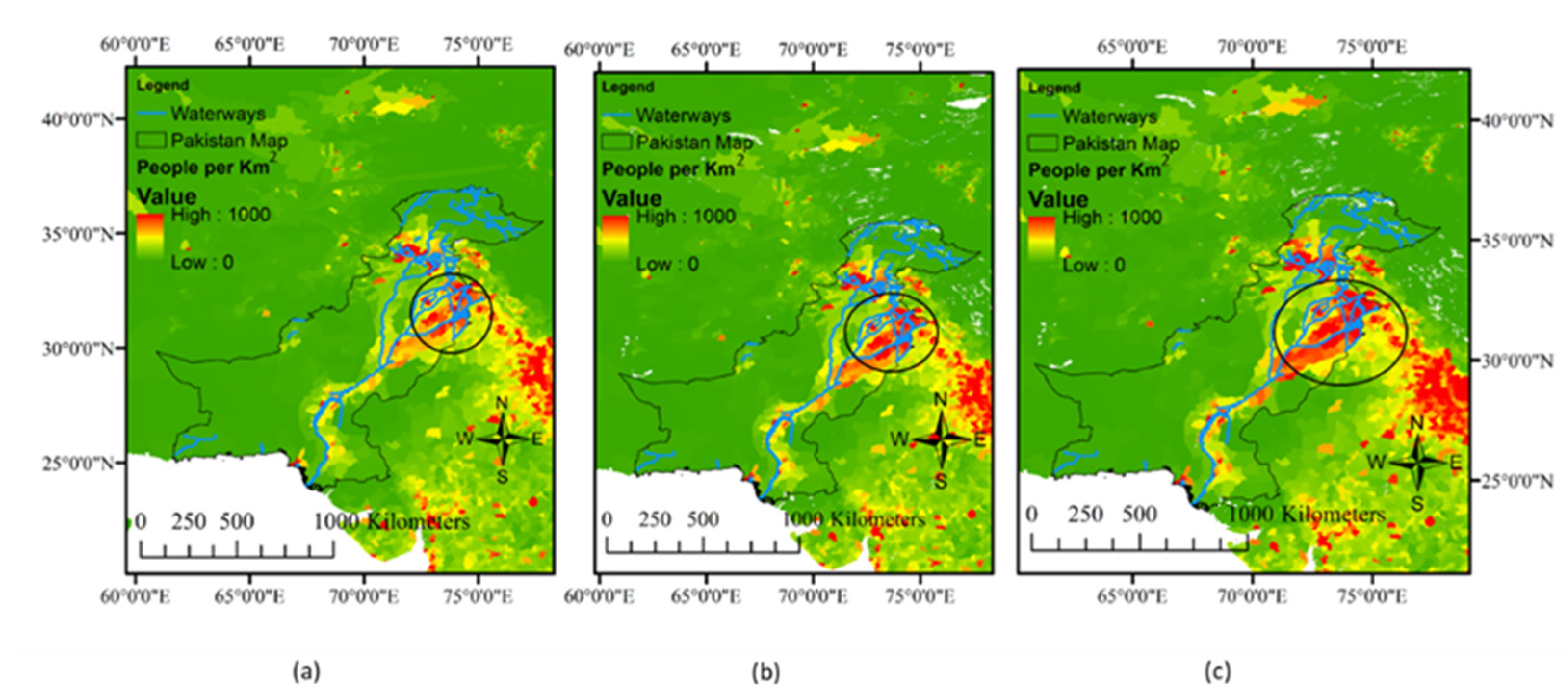
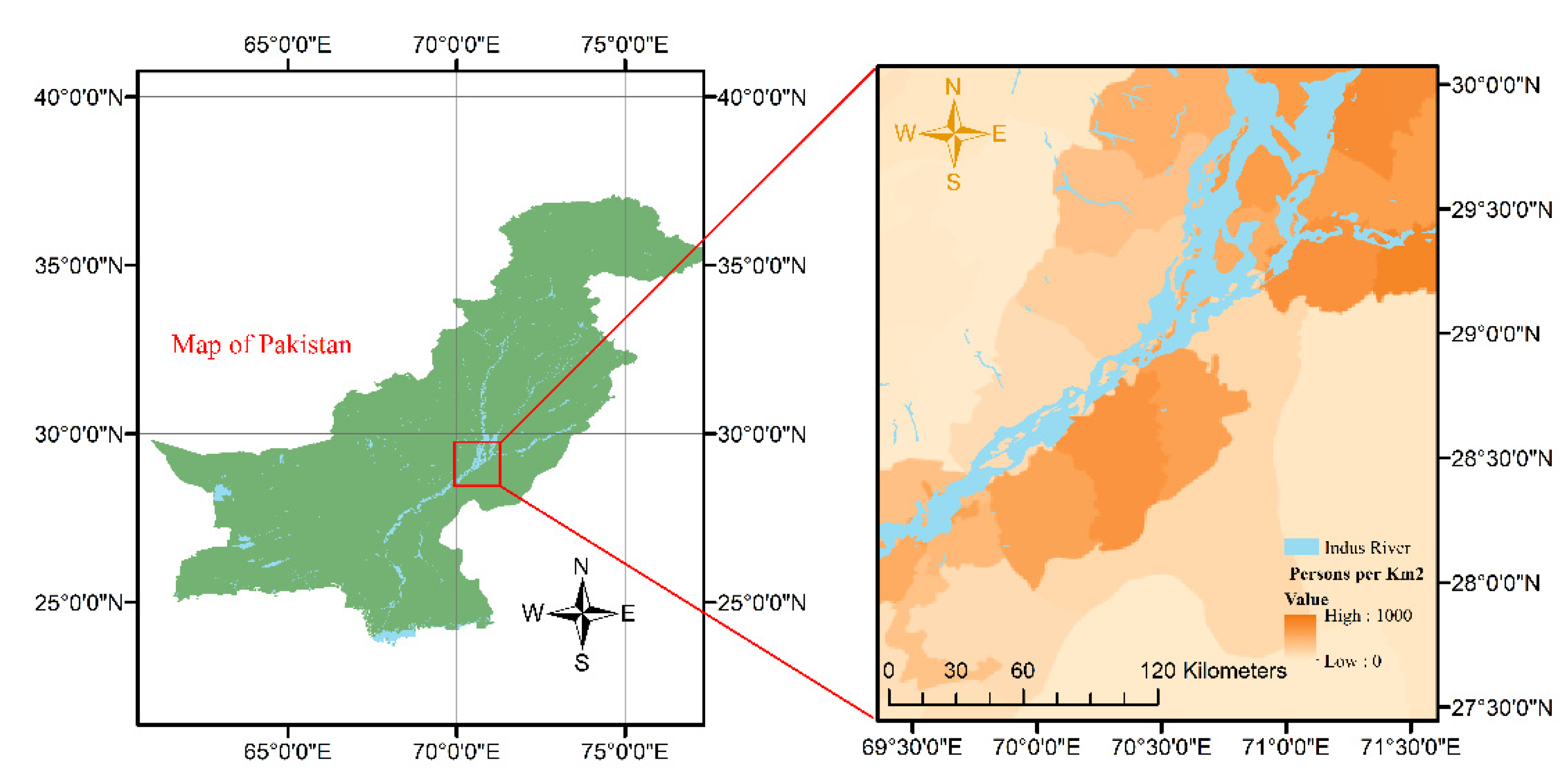


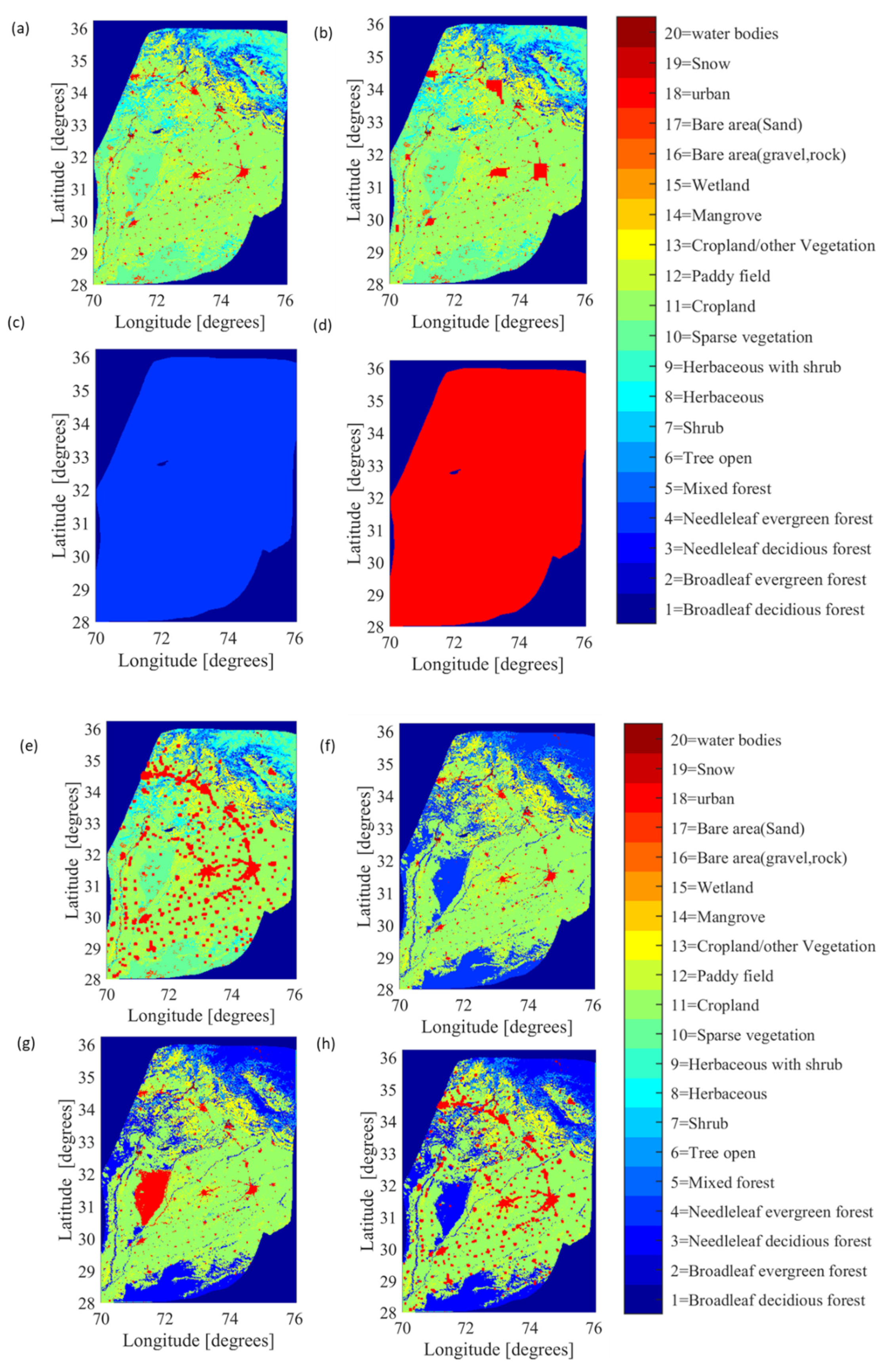
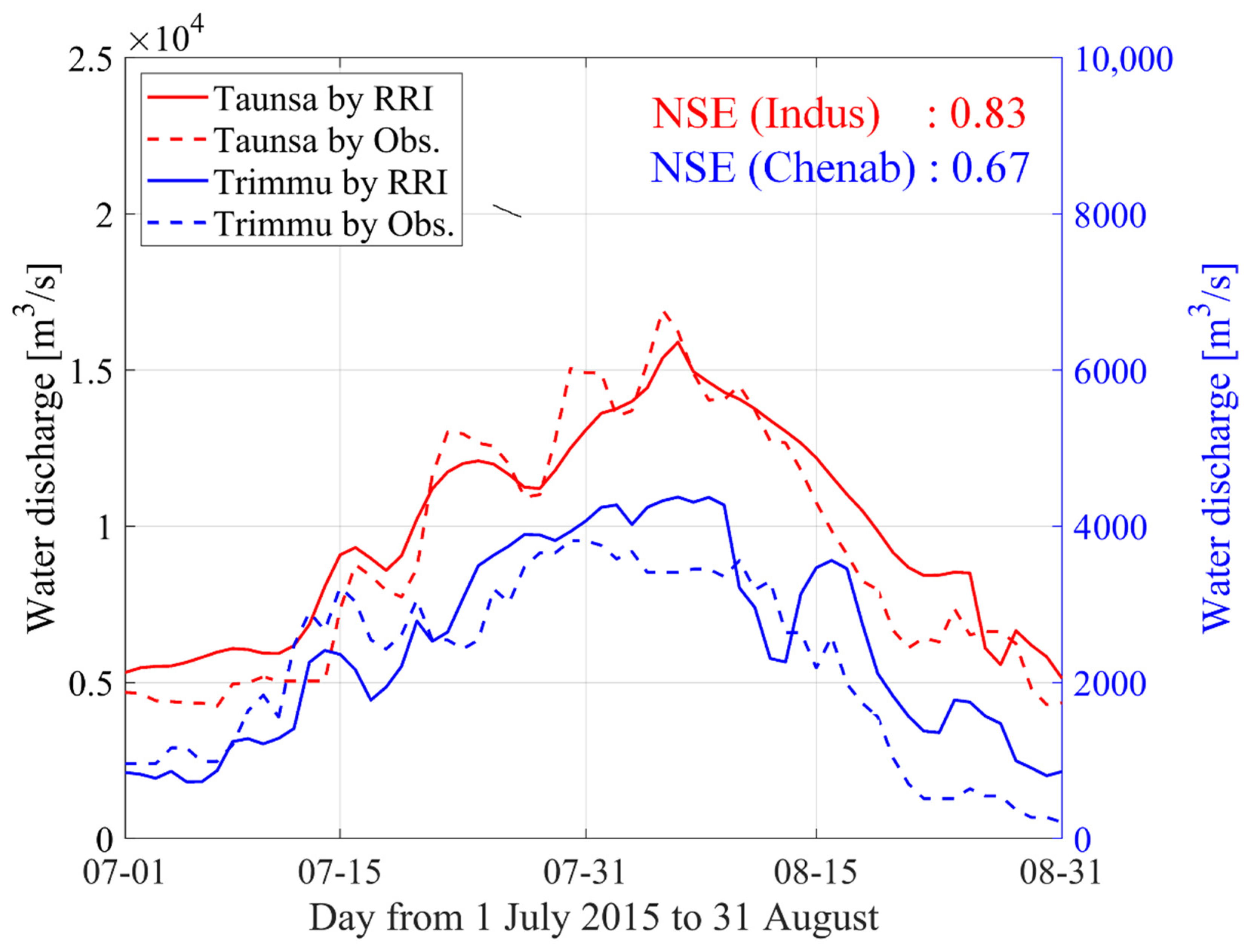
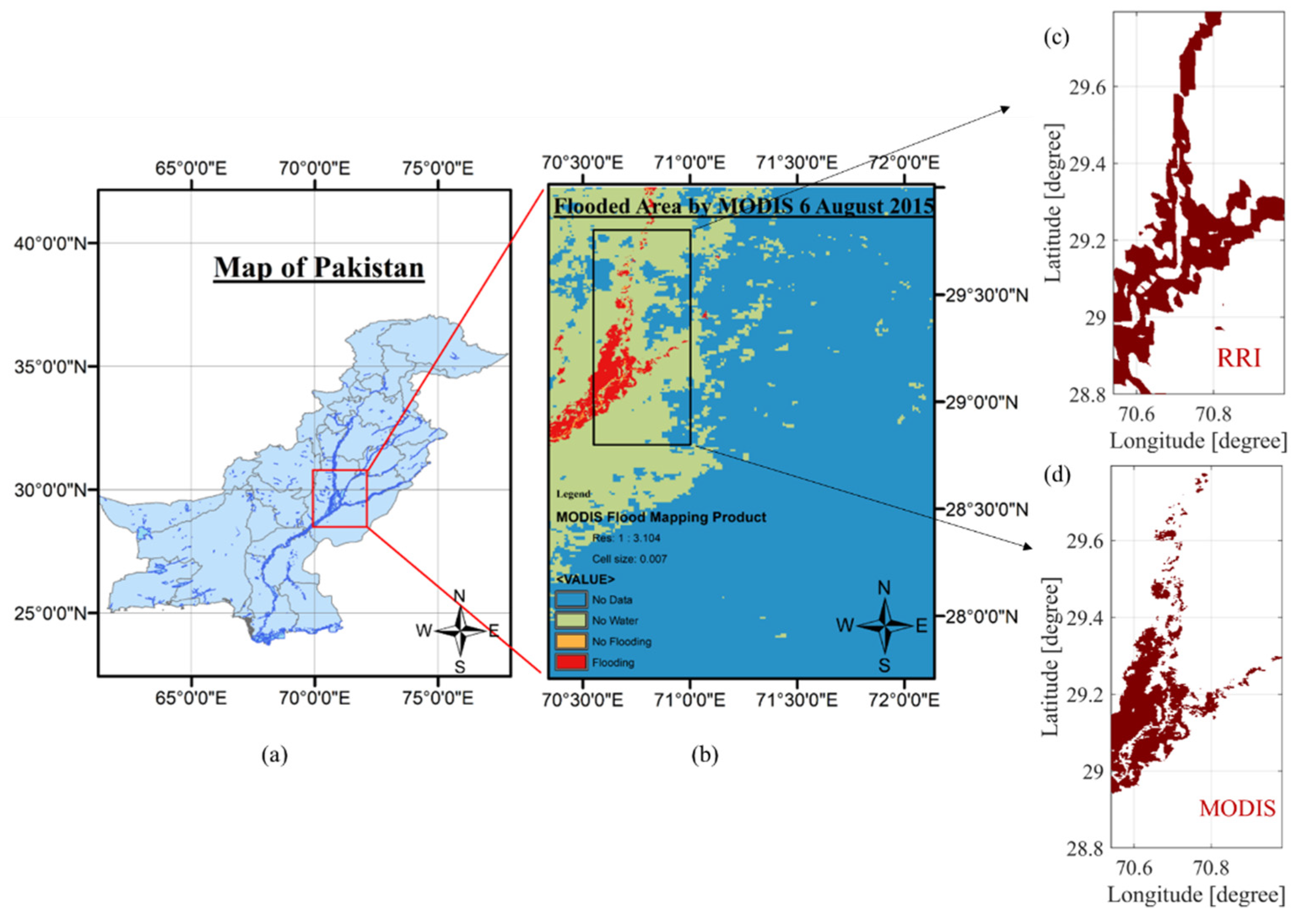


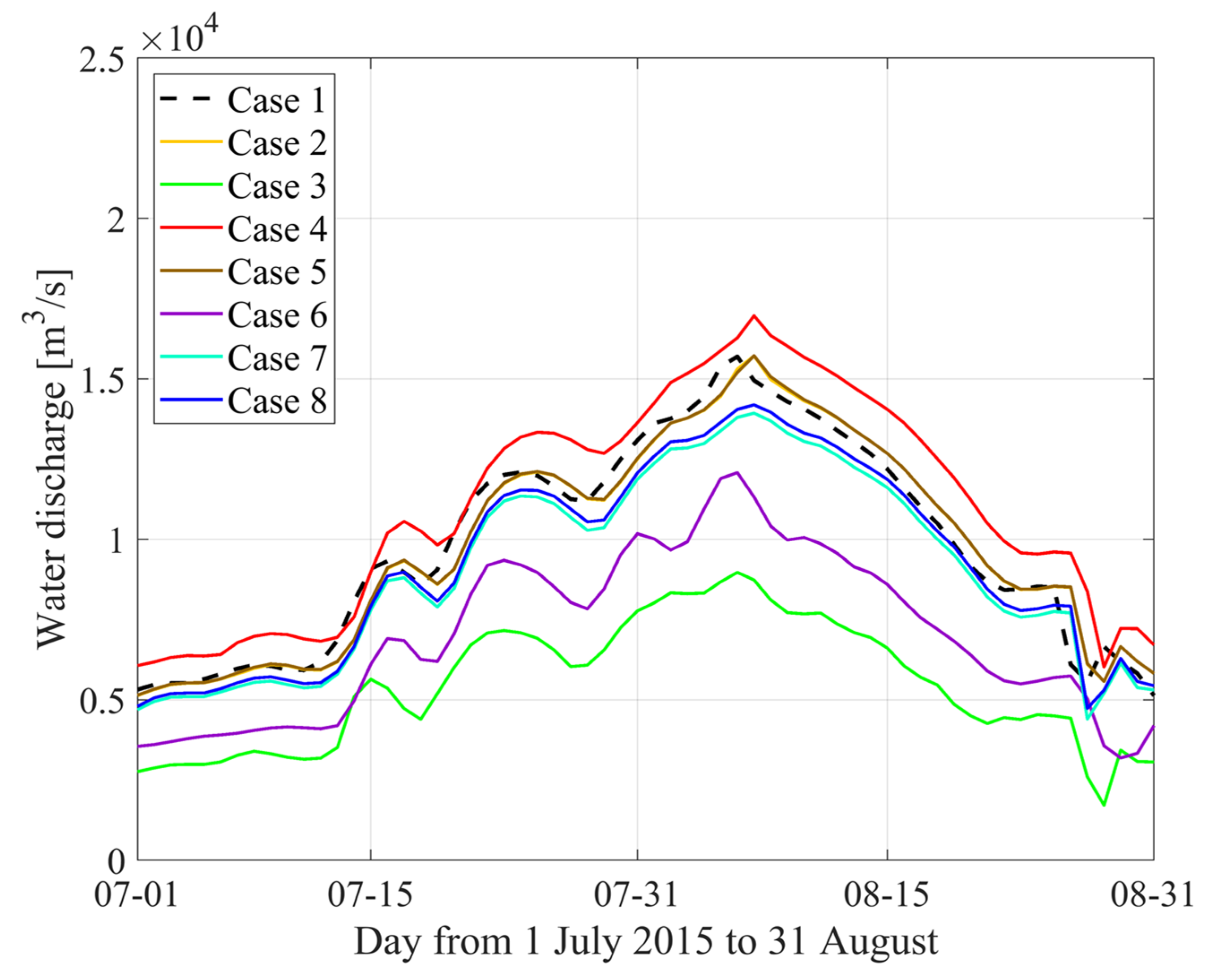
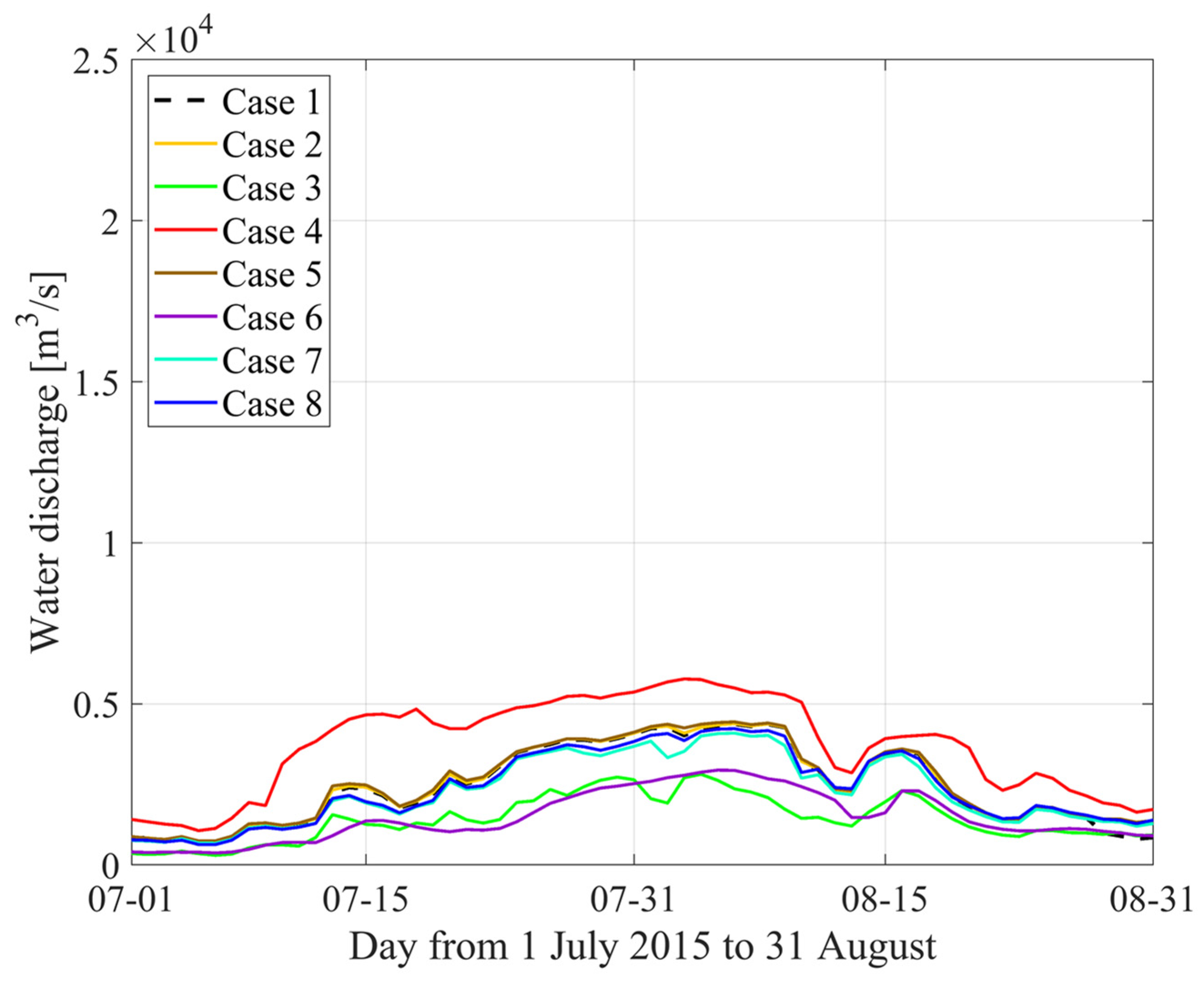
| River width coefficient (Cw) | 3.5 |
| River width coefficient (Sw) | 0.45 |
| River depth coefficient (Cd) | 0.1 |
| River depth coefficient (Sd) | 0.4 |
| Number of grids | 303 × 412 |
| Resolution (degrees) | 1/60 |
| Rainfall input start time | 00:00 UTC 21 June 2015 |
| Rainfall input end time | 00:00 UTC 31 August 2015 |
| Simulation time (h) | 1728 |
| Manning’s roughness, ns (m−1/3s) | 0.025 |
| Output interval (s) | 10 |
| Case 1 | Control case (original case) |
| Case 2 | The urbanization of six cities (Lahore, Islamabad, Peshawar, Faisalabad, D.G. Khan, and Multan) |
| Case 3 | All areas converted into a forest |
| Case 4 | All land cover areas changed to urbanization |
| Case 5 | Urban grids (No. 18) expanded to eight surrounding grids |
| Case 6 | Shrubs, herbaceous and sparse vegetation, and bare areas (Nos. 6, 7, 8, 9, 10, 16, and 17) all converted into a forest |
| Case 7 | Urbanization between the Chenab and Indus Rivers combined with Case 6 area |
| Case 8 | Cases 5 and 6 combined (simultaneous planting and urbanization) |
Publisher’s Note: MDPI stays neutral with regard to jurisdictional claims in published maps and institutional affiliations. |
© 2022 by the authors. Licensee MDPI, Basel, Switzerland. This article is an open access article distributed under the terms and conditions of the Creative Commons Attribution (CC BY) license (https://creativecommons.org/licenses/by/4.0/).
Share and Cite
Shahid, H.; Toyoda, M.; Kato, S. Impact Assessment of Changing Landcover on Flood Risk in the Indus River Basin Using the Rainfall–Runoff–Inundation (RRI). Sustainability 2022, 14, 7021. https://doi.org/10.3390/su14127021
Shahid H, Toyoda M, Kato S. Impact Assessment of Changing Landcover on Flood Risk in the Indus River Basin Using the Rainfall–Runoff–Inundation (RRI). Sustainability. 2022; 14(12):7021. https://doi.org/10.3390/su14127021
Chicago/Turabian StyleShahid, Hamza, Masaya Toyoda, and Shigeru Kato. 2022. "Impact Assessment of Changing Landcover on Flood Risk in the Indus River Basin Using the Rainfall–Runoff–Inundation (RRI)" Sustainability 14, no. 12: 7021. https://doi.org/10.3390/su14127021
APA StyleShahid, H., Toyoda, M., & Kato, S. (2022). Impact Assessment of Changing Landcover on Flood Risk in the Indus River Basin Using the Rainfall–Runoff–Inundation (RRI). Sustainability, 14(12), 7021. https://doi.org/10.3390/su14127021






